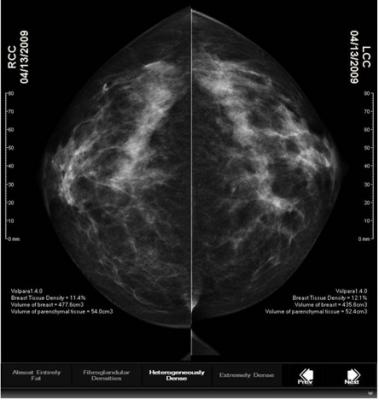
April 29, 2015 — Volpara Solutions announced the release of VolparaDensity version 3.1 at the Society of Breast Imaging’s SBI/ACR Breast Imaging Symposium in Orlando, Florida, April 25-28.
The latest version of VolparaDensity supports digital mammography from all leading vendors and tomosynthesis datasets from Hologic, GE and Siemens tomosynthesis systems. Additionally, VolparaDensity 3.1 supports Hologic sites that use C-View synthetic 2-D images and GE SenoClaire sites that acquire 2-D CC and 3-D MLO images. VolparaDensity uses the same algorithm to process both the acquired tomosynthesis projections and the raw data of a conventional 2-D mammogram. This reduces the challenges of visually determining breast density based on a review of tomosynthesis slices and the new synthetic 2-D images (C-View from Hologic, V-Preview from GE).
“We have been using VolparaDensity for more than two years and find it particularly helpful when assessing breast density in mammograms with a complex dispersion of fibroglandular tissue,” said Kathy Schilling, M.D., of the Christine Lynn Women's Health and Wellness Center at Boca Raton Regional Hospital in Boca Raton, Florida. “We are now very pleased to be using VolparaDensity together with our GE SenoClaire digital breast tomosynthesis acquisitions. Given the demands of reviewing the stacks of tomosynthesis slices and the new synthetic 2-D images, we appreciate the consistent density assessment we get from the Volpara software.”
VolparaDensity 3.1 supports additional features including new configuration flexibility for patient-specific compression pressure calculations and the ability to route patient results by Volpara’s U.S. Food and Drug Administration (FDA)-cleared Volpara Density Grades (VDG), which are analogous to the BI-RADS density categories. Based on a site’s imaging protocols for breast density and risk, users can configure the system to automatically send density results for women with very dense breasts to a specific interpreting radiologist or a breast density specialist at the site for review. This automatic routing may help improve the speed with which sites can identify women who would benefit from additional screening, particularly sites that perform same-day adjunctive screening.
VolparaDensity is in use at breast imaging centers worldwide to help radiologists objectively assess density from both digital mammography and tomosynthesis images and to determine which women would benefit from additional screening. Highly correlated to breast magnetic resonance (MR) assessments, VolparaDensity automatically generates an objective measurement of volumetric breast density correlated to the American College of Radiology (ACR) breast density categories.
For more information: www.volparasolutions.com


 July 29, 2024
July 29, 2024 








